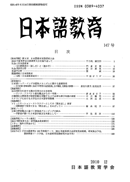Volume 177
Displaying 1-7 of 7 articles from this issue
- |<
- <
- 1
- >
- >|
REGULAR ISSUE
Research Paper
-
2020 Volume 177 Pages 1-16
Published: December 25, 2020
Released on J-STAGE: December 26, 2022
Download PDF (657K) -
2020 Volume 177 Pages 17-30
Published: December 25, 2020
Released on J-STAGE: December 26, 2022
Download PDF (1008K) -
2020 Volume 177 Pages 31-46
Published: December 25, 2020
Released on J-STAGE: December 26, 2022
Download PDF (421K) -
2020 Volume 177 Pages 47-61
Published: December 25, 2020
Released on J-STAGE: December 26, 2022
Download PDF (608K)
Survey Articles
-
2020 Volume 177 Pages 62-76
Published: December 25, 2020
Released on J-STAGE: December 26, 2022
Download PDF (673K)
Practical Articles
-
2020 Volume 177 Pages 77-91
Published: December 25, 2020
Released on J-STAGE: December 26, 2022
Download PDF (1002K)
Research Notes
-
2020 Volume 177 Pages 92-100
Published: December 25, 2020
Released on J-STAGE: December 26, 2022
Download PDF (370K)
- |<
- <
- 1
- >
- >|
